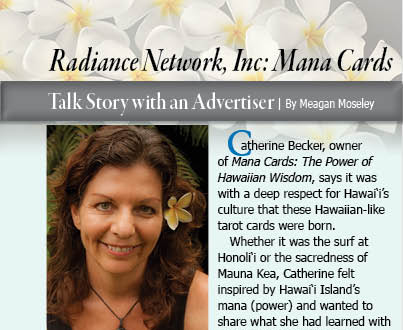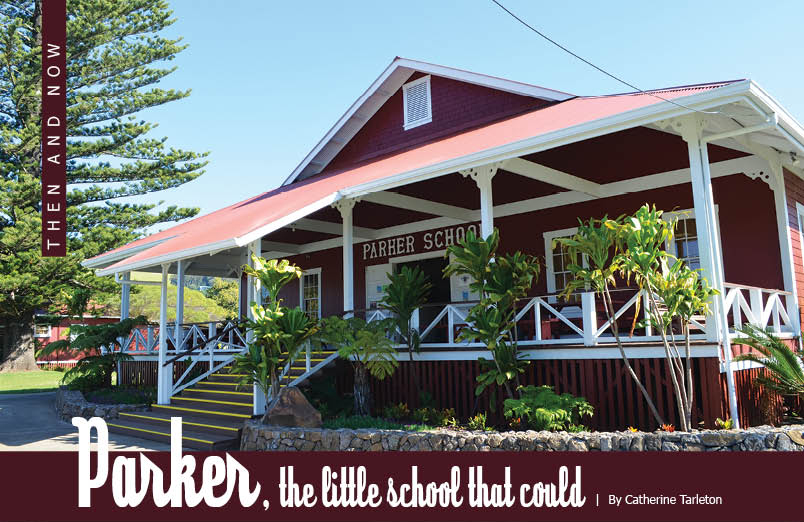
Renaissance at Honomū: Successful Former Residents Return to Help Lift a Sleepy Plantation Town

By Karen Valentine
A sleepy town sits with remnants of yesteryear, while locals and visitors drive by toward the Hāmākua Coast tourist attraction of Akaka Falls. Is there hope of rebirth, perhaps with the right formula of dreams and talent?
Honomū—one of Hawai‘i Island’s formerly bustling plantation towns—might be getting lucky. It’s taken three or four individuals, each with major experience gained elsewhere, yet with roots here and most importantly the passion to come back “home,” to mount an ambitious revitalization campaign.
One is Amy Setsuko Hanahiro, whose grandfather, Kiyoshi grew up in Honomū. He joined the Army, moved to O‘ahu, where he met Amy’s grandmother working at Schofield Barracks. Amy grew up there, while many Hanashiros remained on this island, including some in Honomū. During high school, she lived here for a time and then left to travel the world.
Now, decades later, Amy has become a successful, high-level hotel executive in Japan. In the next several months she is returning to open a fine, Japanese-style inn where the old Ebesu Hotel used to be. Her cousins, June and Dean Edmonson, run the bakery down the street.
Real estate developer Jude Kleila’s grandparents had a home on Ali‘i Drive in Kailua-Kona, where he and his mother stayed for months at a time during both of their childhoods, attending school here and developing a love for Hawai‘i. He remembers Kona from the old days and finds a similar, family-friendly feel in Honomū.
Just so happens that Jude is a fifth-generation Italian-American New York commercial real estate developer who has gained expertise from the ground up, particularly in Florida and the Virgin Islands. He wanted to bring his young family back to Hawai‘i, where he says he wants to die.

In 2012, Jude bought the row of buildings that includes the vacant old hotel, historic Honomū Theater building, a number of shops, and a restaurant on Front Street. In just four years, he’s made it a labor of love to thoroughly renovate the seven buildings in keeping with their old-Hawai‘i style.
“I remember the aloha spirit and I remember the spirit and the beauty of Hawai‘i,” says Jude. I always wanted to come back. It took me 25 years. This is unlike any place I’ve ever been and I’ve traveled all over the world. It’s a perfect place to raise a family and plant roots. I’ve operated many businesses before, including our family business, which has exclusively been involved in commercial real estate since the 1980s.”
Arlene Ashida is the daughter of H. (Richard) Tanimoto, who built a chain of five movie theaters on the island, including the one in Honomū. She came back in the 60s to help the family, and to teach school at Laupāhoehoe. The strip of commercial buildings that Jude bought was owned by her when it went up for sale.
Another local boy, Phil Gillespie grew up in nearby Pāpa‘ikou. He moved to O‘ahu and then the mainland, where he owned and operated four successful hair salons in Southern California. He too wanted to return. After meeting his wife, Susan, and delaying their move while they put three girls through college, they both came back to help Phil’s mother in Pepe‘ekeo and then decided to open a salon in the new Honomū.
“It was the first new store we opened, a very cute little place,” says Jude. “We built the hair salon in their vision.”
Phil and Susan established the salon and took on an apprentice, Keala Palea, whose family is also from old Honomū. After a short time, Keala offered to purchase the business, buying it from the Gillespies, who now work for her.
It’s important to Jude that each space have the personal involvement of the tenants. “My plan was to first purchase the strip, then get the right mix of businesses that cater to both the local residents and visitors: shops, the hotel, and finally food and beverage service. Then we hope it develops the momentum to thrive. I’m not a philanthropist. If I can do something that’s first really appealing to me on a personal level, have it be supported by a community, and at the same time it is old Hawai‘i, that will be rewarding.”
The next space to be renovated was the old hotel space that had been vacant for decades. “While first looking at the building, I fell right through the floor,” he laughs. His wife SherryLee concurs. “The floors were Swiss cheese.”
“At one time Honomū was known as a real rough-and-tumble place,” says Jude. “There were three bars, and each night the patrons would beat each other up on the street out in front and then go to the hotel to lick their wounds.”
There evidently were enterprising women who would help them with that.
“So I’m walking around and thinking this could be a nice B&B. I put a notice on Craigslist, asking if anyone was interested in a space in Honomū. Several responded and one was Amy Hanashiro. After a lengthy correspondence we came to an agreement, worked together, and designed the space in accordance with her vision, which is to cater to the Japanese market.”
“When I visited,” says Amy, “I walked into the bakery to get a pastry and saw an old photo on the wall. I asked who that was and they said it was the Hanashiro family, who owned the bakery! It turned out to be my cousins, whom I hadn’t seen in 20 years!”
Now Amy’s daughter, Michiko, is here to oversee and take care of the almost-finished hotel space until Amy can be there full-time. At the present, she is still employed in Japan as a very busy executive assistant manager at the exclusive Oakwood Premier Tokyo apartment/hotel in the center of the city.
“She’s worked her way from the bottom to the top,” says Michiko. Amy started as a housekeeping manager in hotels in Guam, where she settled after first graduating school in Hawai‘i, then traveling to San Francisco and Australia. “She worked her way up and became manager at Westin, where she worked throughout my childhood.”
Amy worked with Westin, opening hotels all over the world, and eventually moved to Japan, where they lived first in Sapporo, Hokkaido, then moved to Tokyo for her present job. Coming back to Hawai‘i is a dream that will soon come true, as she is eligible for retirement after the end of this year, says Michiko.
“The dream is my mother’s and father’s. This is their retirement, which is funny, because if you know my mom, she loves to keep busy always.”
Amy has already collected a vast network of potential guests for the Honomū Inn, from famous Hawaiian sumo wrestlers to distant family members who hear of the inn and want to visit.
The design of the Honomū Inn space includes bathrooms with lower sinks and toilets that will include heating and bidet features. The décor is minimalist, clean, and light. Amy has a love of miniature tea sets and other fine arts and crafts, which she plans to incorporate into the rooms. They will add to the blend of historic and modern. She organizes a large art fair in Tokyo and hopes to do something similar here.
An original wall mural featuring Akaka Falls is seen as you descend the wide staircase. The artist is Wile‘e Gillespie, daughter of Phil and Susan.
Jude, whose experience in St. Croix with astronomical electric rates has made him more energy conscious, has installed LED lighting throughout the new spaces. In the hotel, the lighting has a historic look, and there are beautiful wood floors, white painted walls and plantation-style details. In addition, he purchased innovative controls called Watt Stopper, where hotel guests must insert a card into a slot to turn on the power and remove it when they leave. Clean and sleek, through-the-wall air conditioning units are slim and quiet, as the individual condensers sit on the roof. They only run when rooms are occupied.
Along the fronts of the buildings is a new boardwalk, constructed with locally harvested and milled Eucalyptus robusta, which has a look similar to koa.
Continuing the theme of “all in the family,” at the end of the boardwalk is a space being renovated to become a Japanese diner, which will be operated by Amy’s husband, Masanori Kishima, who is currently the head chef at Oakwood Premier.
“That’s where my dad would come in,” Michiko says. “He will run the diner, be head chef and do the cooking, everything. The style we are looking for is more obento for lunch, and for dinner shabu shabu, which is a kind of hot pot with vegetables and meat.”
They hope to open the diner sometime around the end of the year or first of next year and have enticed another cousin, Michael, to return from Tokyo and be part of the enterprise.
“We also want to support family members at the bakery down the road with a complimentary card where guests could get hot pastry, coffee, and bakery goods.”
Another traditional offering as a Japanese inn, Michiko says, is to offer services such as laundry, as well as a personalized welcome basket for each guest, tailored from background information they provide on a registration card.
Tenants in place when Jude purchased the buildings included five existing businesses.
“Even though Honomū was in decline, it had commerce, although it wasn’t in the condition we’re improving it to now,” says Jude. We went in and started doing one space at a time. The most important take-away, I feel, is we didn’t just throw on a coat of paint. We have deeply preserved the buildings and put in infrastructure. And in doing so, it’s now safe, viable and within legal requirements.”
There were a few challenges and some remain, including the renovation of the historic theater building.
The county wouldn’t allow a regular septic system, Jude says, because of relatively new rules calculating standardized water usage deduced from a guideline he thinks came from a large city.
“The hair salon couldn’t use the amount of water they estimate for one month in two years!”
So they installed a special micro sewage treatment plant in the back to handle wastewater. The developer thinks it might be the only one on the island at this time.
“The theater is really in the worst state of repair. Half of it had fallen down—the entire screen and stage portion in back is now missing. It is a 5,000 to 6,000 sq. ft. space that needs an operator; many ideas have been tossed around. A bunch of things need to come together to make the theater building happen.”
The building’s status being on the historic registries makes it tricky, too. “The bottom line is we’re committed to doing something.”
The momentum is underway. With all the history, talent, and passion being injected into the little town, it’s certain to thrive into the next decades to come.
“With the attraction of Akaka Falls, we have built-in traffic as well as a local community to serve. My bottom-line thesis is that if there is a project that can make it in the modern era, then Honomū can,” says Jude. “It should go. We’ve already finished most of what I set out to do. At a certain time, with food and beverage coming on line, we’ll see what happens. In a few months we’ll know.” ❖
Contact Jude Kleila
Contact writer/photographer Karen Valentine


